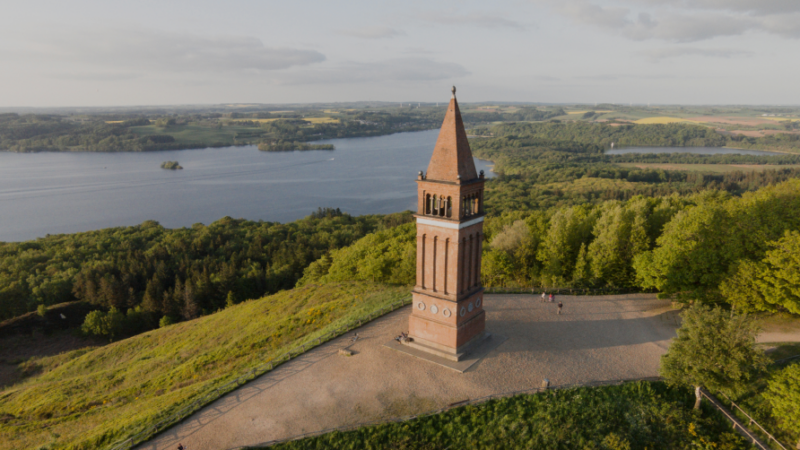
Welcome to Himmelbjerget
Despite the fact that Himmelbjerget rises 147 metres above sea level, the geologists claim that Himmelbjerget is a “false” hill. When the Ice Age was over, the enormous glacial streams dug into the ground and formed the subglacial stream trenches whose steep slopes form the »false« hill – as opposed to the “genuine” hill which is evenly rounded on all sides. In the subglacial stream trench formed by the glacial streams you find today the beautiful lake Jul-Sø, originally Hjul-Sø (the name refers to a place of worship), above which Himmelbjerget rises.
In Old Norse Mythology, Himmelbjerget is the place beside the rainbow, Bifrost, where Heimdal, the guardian of the Gods lived. Bifrost connected Asgård of the Gods to Midtgård of the people.
For a long time it was believed that Himmelbjerget was the highest point in Denmark, but in the last part of the 1800’s the places, Ejer Bavnehøj and Yding Skovhøj, took over that honour.
In the Middle Ages the area belonged to the monks of Øm Monastery who owned large tracts of the Lake District. During the Reformation in 1536 the Crown expropriated the lands of the monasteries and formed the Skanderborg Game Preserve reserved for Royal Hunts. The woodlands and game were preserved and Foresters and game-wardens were appointed. To the west of Himmelbjerg, glass was produced for among other things castle windows during the last decades of the 1500’s. At the end of the 1600’s the area was used as a Cavalry District housing members of the Danish Cavalry. In 1767 the Cavalry District was sold by auction at Skanderborg Castle and ownership in the Lake District came into the hands of many large and small landowners.
From 1839 onwards a tradition grew up for holding open-air meetings on Himmelbjerget to discuss the future of Denmark. In 1875 the tower on Himmelbjerget was built to celebrate the Constitution and thereafter other memorials were established. Landscape painters did much to make the Lake District well known and, with the arrival of steam-boats (1861) and the railways (1871), it became easier to visit Himmelbjerg.
The memorials on Himmelbjerget
The memorials were raised in connection with anopen-air meeting or Constitution meetings.
The poet/priest, Steen Steensen Blicher was the first person to arrange an open-air meeting there in 1839. During what could be described as the “Golden Age” for meetings, 1862-86, Himmelbjerg Tower was built in memory of King Frederik 7th – the king who gave the Constitution.
At meetings in the 1880’s the most important memorials were raised – the Blicher Stone and the Tscherning Stone.Tscherning was the champion of the movement for farmers’ rights and he had a place among the people who formed the Constitution. Later the memorials for the women’s right to vote were raised – The Woman Oak and Woman Stone. On the occasion of the Constitution’s 150th Anniversary a sculpture was mounted called“Mind and letter”.
Memorials were raised in memory of the priest, Vilhelm Beckand Leopold Budde, the man who started the children’s home, Himmelbjerggården, south of Himmelbjerget.
Many writers, authors and politicians have made speeches at open-air meetings and Constitution celebrations and therefore the podium itself could be called a memorial on Himmelbjerget.
Contact
Tårnkomitéen
Tinghusvej 4
8680 Ry
info@himmelbjerget.dk
Opening hours
The tower:
Palm Sunday – 30. april
Weekends and holidays 10.00-17.00
May – July
All days 10.00-17.00
August. – 15. sept.
All days 10.00-17.00
16. sept. – 30. sept. the two first weekends in October and Autumn Holidays
Saturday and Sunday 10.00-17.00